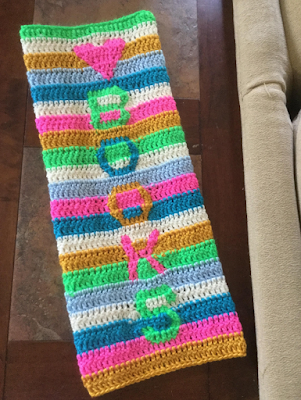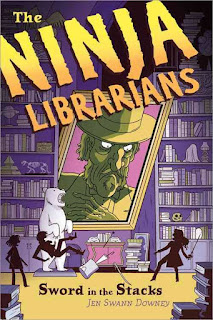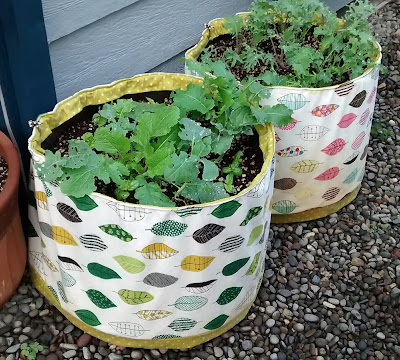Sunday, June 26, 2016
Blue, green and purple newsboy hat
This newsboy-style hat, in panels of blue, green and purple, repurposes fabric from a purple tunic, a blue and green floral-print dress and a green-lace skirt. The hat-band, in green and white stripe, was a remnant of grab-bag fabric.
As with previous creations this hat represents a variant on the Hat People design, with the hat-band my unique addition. I like to add a hat-band because it presents one more opportunity to use a contrasting or complimentary fabric that really pulls the whole design together.
Saturday, June 25, 2016
‘Ninja Librarians: Sword in the Stacks’
It was such a delight to read The Accidental Keyhand, first book in The Ninja Librarians, that I eagerly accepted an invitation by series author Jen Swann Downey to read the second book.
As Sword in the Stacks opens (Sourcebooks Jabberwocky, 2016), young protagonists Dorrie and Marcus begin their training as official apprentices to the Lybrariad, a secret society that aids people who were persecuted throughout history for expressing their ideas.
This fantasy series builds upon the image of the library professional as a defender of intellectual freedom and endows its characters with swashbuckling derring-do.
As Sword in the Stacks opens (Sourcebooks Jabberwocky, 2016), young protagonists Dorrie and Marcus begin their training as official apprentices to the Lybrariad, a secret society that aids people who were persecuted throughout history for expressing their ideas.
This fantasy series builds upon the image of the library professional as a defender of intellectual freedom and endows its characters with swashbuckling derring-do.
Thursday, June 23, 2016
Professional communication and editing
My part-time work for a local church includes posts to social media, “MailChimp” email campaigns and updates to the church blog. The spirit of connecting people with information and resources infuses my work with the church, and is consistent with my work in the field of library service.
Monday, June 20, 2016
Keep politics out of LOC subject headings
 |
| Source of image: American Library Association |
Saturday, June 18, 2016
Planter slipcovers from fabric
Black-cloth planters provide utilitarian and practical housing for a small garden of peppers and kale, but aesthetically, they’re rather “industrial.” Fortunately, we found brightly-patterned canvas fabric at Sew Creative in downtown Ashland, Oregon. At the beginning of June, I used this wonderfully colorful fabric to fashion planter slipcovers.
Saturday, June 11, 2016
‘Re-Thinking Autism’
Re-Thinking Autism covers a lot of ground, making it difficult for this reviewer to single out individual contributions.
I think reactions to this book will vary greatly depending upon readers’ interests and circumstances.
The book positions itself as contributing to “critical autism studies” with four objectives:
1. To challenge the evidence base for biomedical models of autism,
2. To explore the impact of the diagnosis on the lived experience of people so labeled,
3. To offer a conceptual critique of the production, consumption and commodification of autism in the twenty-first century in a global context, and
4. To explore ideas for service provision and practice that move beyond a focus on the diagnosis.
This book is at its strongest when advocating for accommodations and services to be made available without first demanding a medical diagnosis.
Requiring people to “prove” their possession of what can be an “invisible” disability, lets society off the hook for the barriers it imposes against full participation by everyone. It also perpetuates inequality — those who can afford the expense and time of getting an “official” diagnosis are allowed access to concessions, while those who can’t afford to obtain diagnosis through an accepted avenue, must struggle to meet social norms.
I believe the book to be less-successful at examining the impact of an autism “label” on the person who actually bears it. In this aspect of critical autism studies, people who are themselves on the spectrum ought to lead the discussion and — unless I missed something in my reading — I could not find a first-hand perspective among contributions to this book.
If I did miss something, I’d appreciate being told, so I can update this response.
I've read several blogs by people on the spectrum and — far from feeling stigmatized by the label of “autism” — they find their possession of a known diagnosis to be vastly preferable to the labels they would otherwise have been subjected to.
I want to offer my perspective as an “expert by experience.” Given the authors’ acknowledgement of these experts’ belonging in a cross-discipline approach to autism, I believe my personal experience has direct bearing in discussion of this book.
From kindergarten onward, I was a school-wide outcast whose classmates taunted and shunned me. No one offered me a diagnosis of “autism,” but surely the ugly names imposed upon me by my classmates carried far greater stigma.
I hold a similar view of unsolicited criticisms that other adults offered to my parents: I would far rather have been known as “autistic” than be labeled a “brat.”
Only in adulthood, did I receive the label that, quite frankly, liberated me.
I’d known all along that I was “different” from everyone, and this finally provided me with the explanation I needed as to why I felt like an alien on earth.
If you would truly understand the impact of an autism diagnosis, then you have to include my experiences, or the experiences of others like me. We are the ones who live with the “impact” that researchers discuss academically.
Disclosure of Material Connection: I received a review copy of this book from the publisher. The opinion expressed is my own. I am disclosing this in accordance with the Federal Trade Commission’s 16 CFR, Part 255: “Guides Concerning the Use of Endorsements and Testimonials in Advertising.”
I think reactions to this book will vary greatly depending upon readers’ interests and circumstances.
The book positions itself as contributing to “critical autism studies” with four objectives:
1. To challenge the evidence base for biomedical models of autism,
2. To explore the impact of the diagnosis on the lived experience of people so labeled,
3. To offer a conceptual critique of the production, consumption and commodification of autism in the twenty-first century in a global context, and
4. To explore ideas for service provision and practice that move beyond a focus on the diagnosis.
This book is at its strongest when advocating for accommodations and services to be made available without first demanding a medical diagnosis.
Requiring people to “prove” their possession of what can be an “invisible” disability, lets society off the hook for the barriers it imposes against full participation by everyone. It also perpetuates inequality — those who can afford the expense and time of getting an “official” diagnosis are allowed access to concessions, while those who can’t afford to obtain diagnosis through an accepted avenue, must struggle to meet social norms.
I believe the book to be less-successful at examining the impact of an autism “label” on the person who actually bears it. In this aspect of critical autism studies, people who are themselves on the spectrum ought to lead the discussion and — unless I missed something in my reading — I could not find a first-hand perspective among contributions to this book.
If I did miss something, I’d appreciate being told, so I can update this response.
I've read several blogs by people on the spectrum and — far from feeling stigmatized by the label of “autism” — they find their possession of a known diagnosis to be vastly preferable to the labels they would otherwise have been subjected to.
I want to offer my perspective as an “expert by experience.” Given the authors’ acknowledgement of these experts’ belonging in a cross-discipline approach to autism, I believe my personal experience has direct bearing in discussion of this book.
From kindergarten onward, I was a school-wide outcast whose classmates taunted and shunned me. No one offered me a diagnosis of “autism,” but surely the ugly names imposed upon me by my classmates carried far greater stigma.
I hold a similar view of unsolicited criticisms that other adults offered to my parents: I would far rather have been known as “autistic” than be labeled a “brat.”
Only in adulthood, did I receive the label that, quite frankly, liberated me.
I’d known all along that I was “different” from everyone, and this finally provided me with the explanation I needed as to why I felt like an alien on earth.
If you would truly understand the impact of an autism diagnosis, then you have to include my experiences, or the experiences of others like me. We are the ones who live with the “impact” that researchers discuss academically.
Disclosure of Material Connection: I received a review copy of this book from the publisher. The opinion expressed is my own. I am disclosing this in accordance with the Federal Trade Commission’s 16 CFR, Part 255: “Guides Concerning the Use of Endorsements and Testimonials in Advertising.”
Friday, June 10, 2016
Yarn bombing at Dover Public Library
 |
| Image credit:Dover Public Library |
Posted to Yarn Bombing at Your Library on Facebook
Thursday, June 9, 2016
Timaru Library, NZ: Yarn bombing planned
At the Timaru Library in New Zealand, crafters are creating artwork for International Yarn Bombing Day on Saturday, June 11. Via a news account published by the Timaru Herald: the exhibition is part of a “Now we’re talking” project to raise awareness of family domestic violence. It will be on display from 10 a.m. to 1 p.m. Saturday.
Posted to Yarn Bombing at Your Library on Facebook
Posted to Yarn Bombing at Your Library on Facebook
‘On Your Mark, Get Set ... READ!’
Jackson County Library Services is promoting “Summer Read” activities that begin as soon as school lets out. Registration is free, and sign-ups can be done at any branch in the system.
Friday, June 3, 2016
‘Ashland Reads,’ book donation to Bellview library
A bagful of books was waiting for me, courtesy of the Rotary Club of Ashland, when I returned to Bellview library after the Memorial Day weekend. The books were donated through “Ashland Reads,” a celebration of literacy.
Thursday, June 2, 2016
‘Magruder’s Curiosity Cabinet’
A sense that outcasts were building their own society particularly appealed to me when reading Magruder’s Curiosity Cabinet by H.P. Wood (SOURCEBOOKS Landmark, June 2016).
For the tourists who flock to Coney Island, circa 1907, Magruder’s is a “dime museum” in a less-fashionable area of the park. Dominant cultural attitudes about race, sexual orientation, gender presentation and “typical” physicality mean that sideshow performers are subjects of curiosity for ticket-paying tourists, but they are also marginalized and excluded from broader society. In the museum basement, Magruder’s provides a gathering place for the performers free from tourists’ stares.
For the tourists who flock to Coney Island, circa 1907, Magruder’s is a “dime museum” in a less-fashionable area of the park. Dominant cultural attitudes about race, sexual orientation, gender presentation and “typical” physicality mean that sideshow performers are subjects of curiosity for ticket-paying tourists, but they are also marginalized and excluded from broader society. In the museum basement, Magruder’s provides a gathering place for the performers free from tourists’ stares.
Subscribe to:
Comments (Atom)
Subject Classifications (Partial list, via Dewey Decimal System)
- 006.754-Social Media
- 020-Library and Information Science
- 020.7025-Library Education
- 020.92-Cynthia M. Parkhill (Biographical)
- 023.3-Library Workers
- 025.00285-Digital libraries
- 025.04-Internet Access
- 025.2-Libraries--Collection Development
- 025.213-Libraries--Censorship
- 025.3-Libraries--Cataloging
- 025.84-Books--Conservation and restoration
- 027.473-Public Libraries--Sonoma County CA
- 027.663-Libraries and people with disabilities
- 027.7-Academic Libraries--University of Central Missouri
- 027.8-School Libraries--Santa Rosa Charter School for the Arts
- 028.52-Children's Literature
- 028.535-Young Adult Literature
- 028.7-Information Literacy
- 158.2-Social Intelligence
- 302.34-Bullying
- 305.9085-Autism (People with Developmental Disabilities)
- 306.76-Sexual orientation and gender identity
- 371-Schools--Santa Rosa Charter School for the Arts
- 371-Schools--Santa Rosa City Schools
- 636.8-Cats
- 646.2-Sewing
- 658.812-Customer Service
- 659.2-Public Relations
- 686.22-Graphic Design
- 700-The Arts
- 746.43-Yarn bombing (Knitting and Crochet)
- 808.51-Public Speaking
- 809-Book Reviews







